May 9th, 2020
Today one of the baby great horned owl chicks either fell, or tried to fly from the nest. While clearing some brush my helper noticed the baby owl clinging to a branch on a large brush pile.
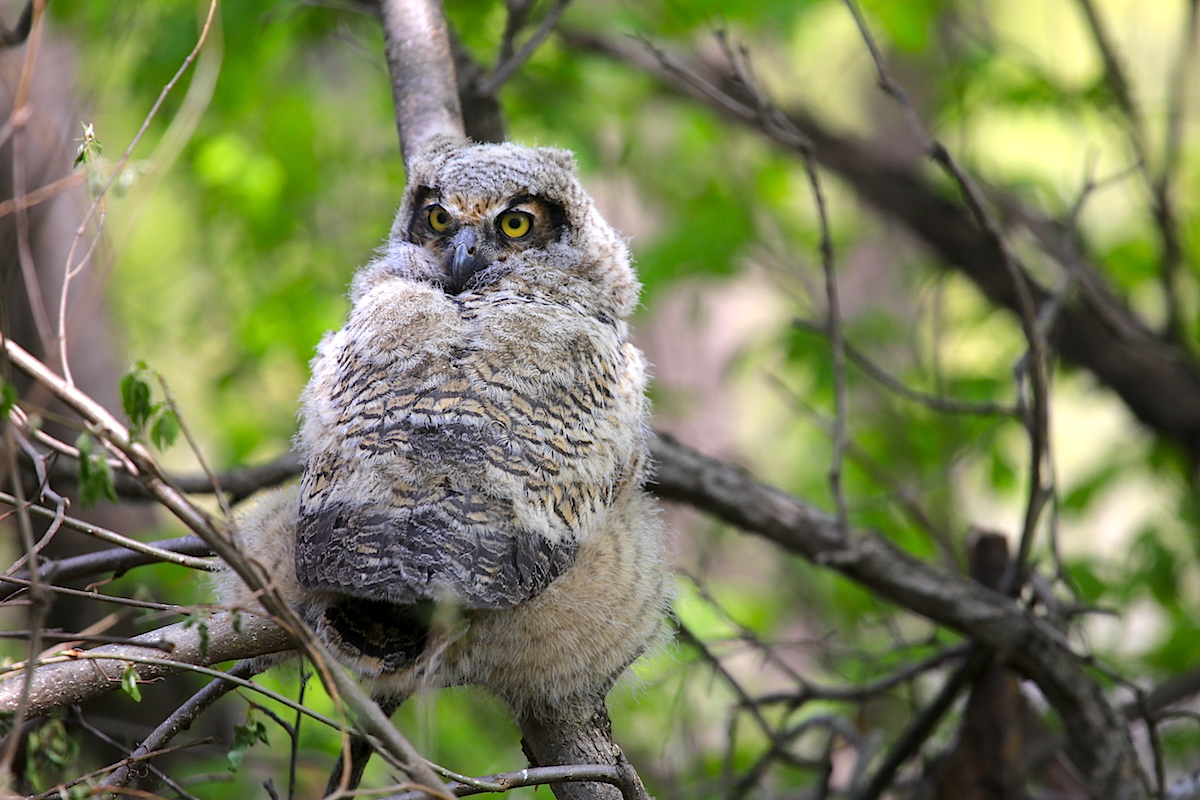
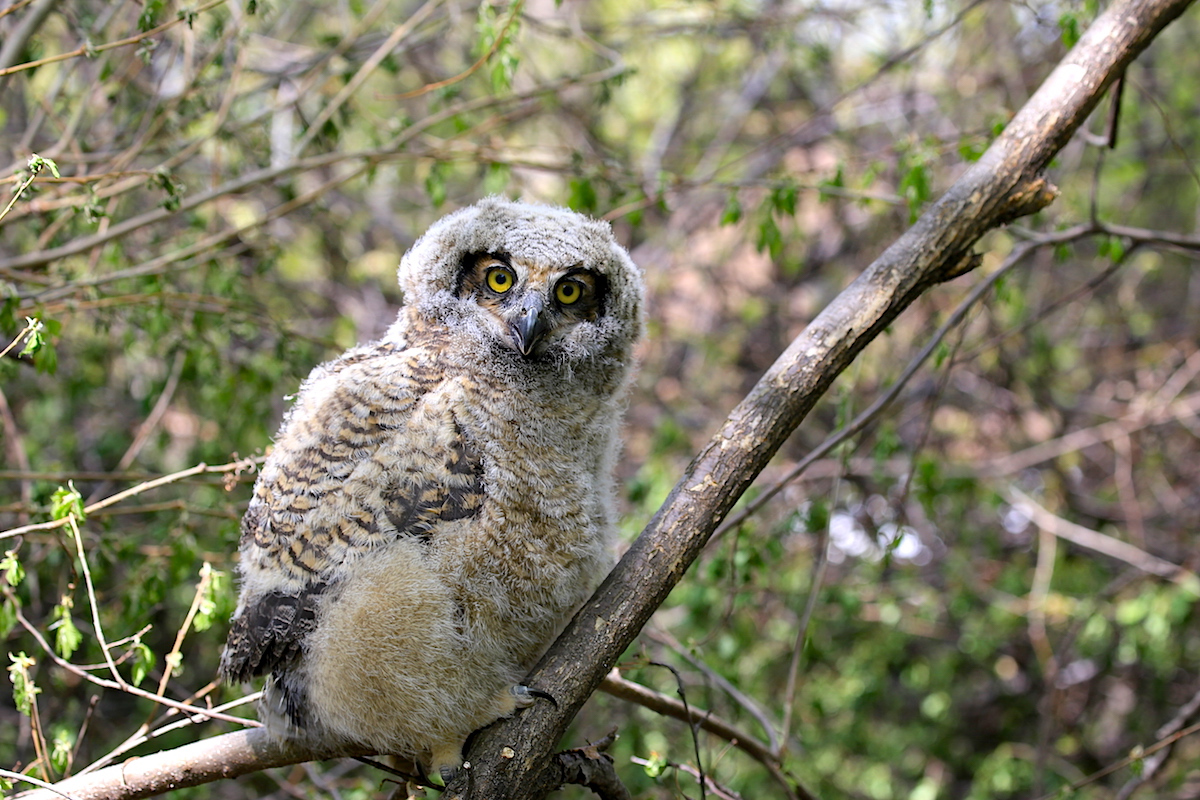
I took a few pictures, then left it alone while I went in to figure out what I should do if anything. The recommended way to deal with a premature departure from the nest is to make a nest near the original and leave the baby alone. The owls will feed it and take care of it. I decided if it became necessary I would do something before dark to keep some critter from eating it. I noticed the little owl walking across the yard from the brush pile to the nest tree, looking up trying to figure out how to get back to the nest.
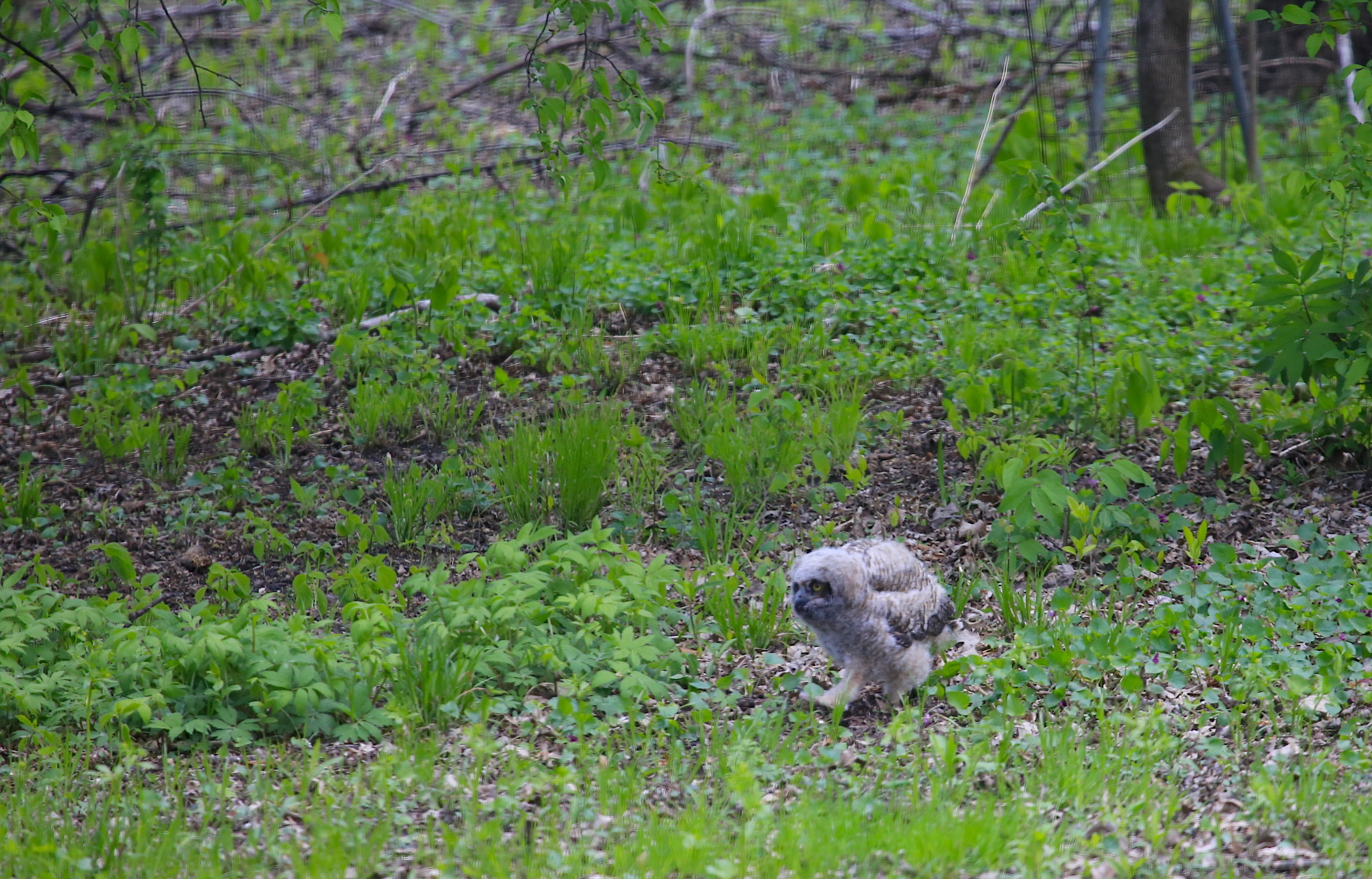
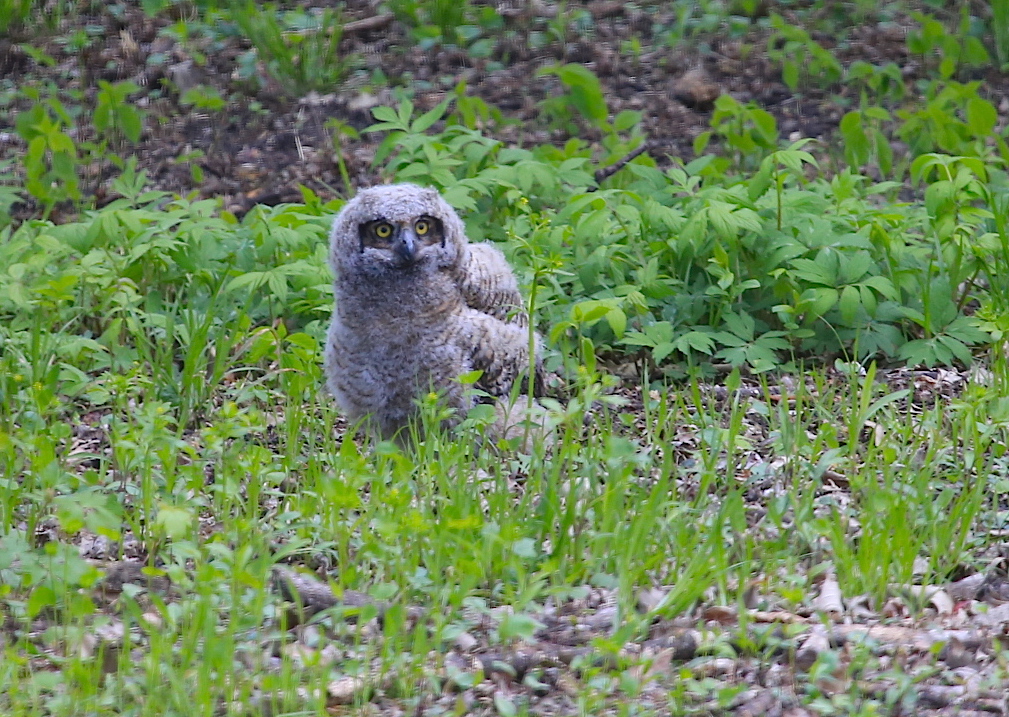

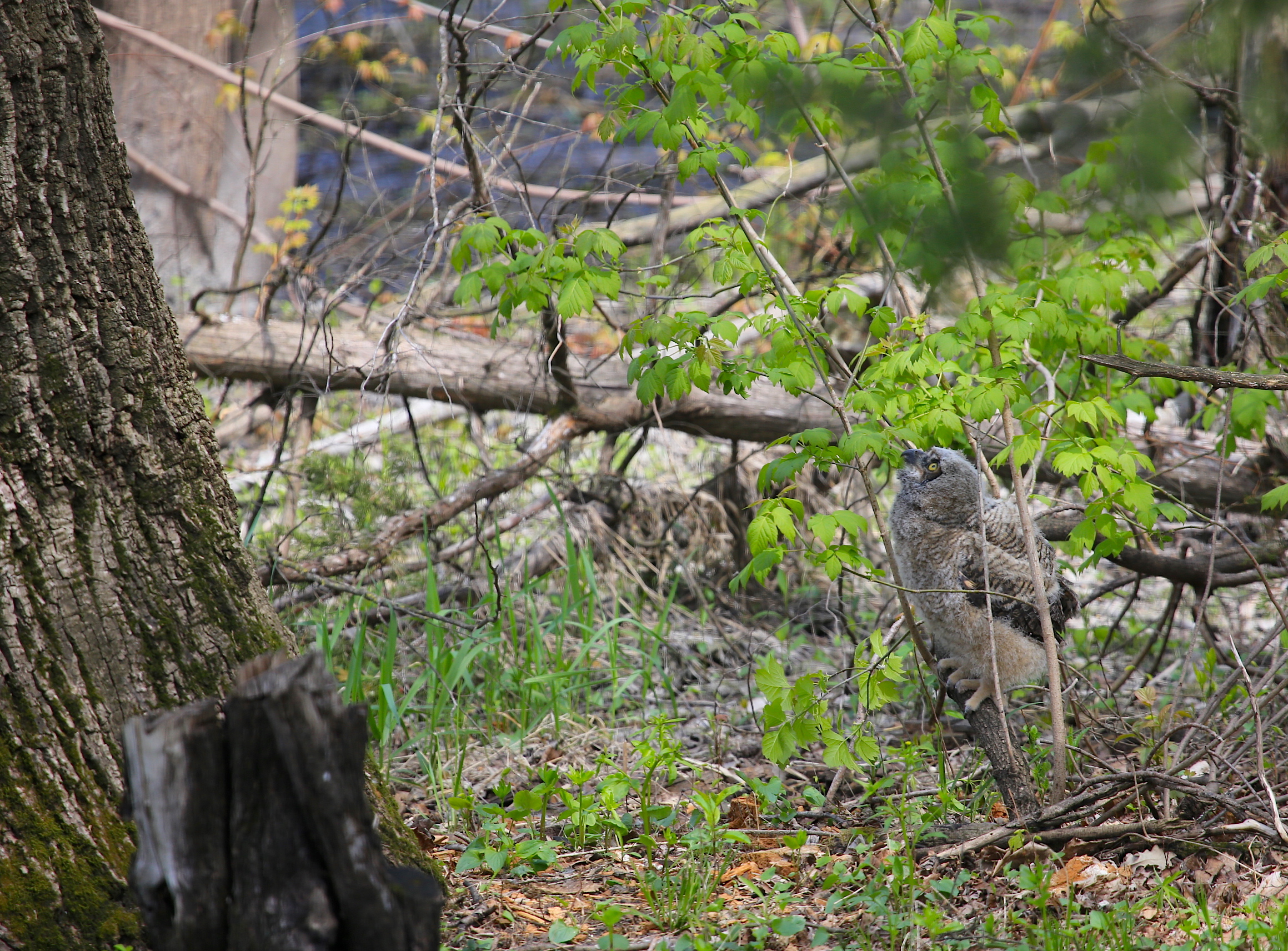
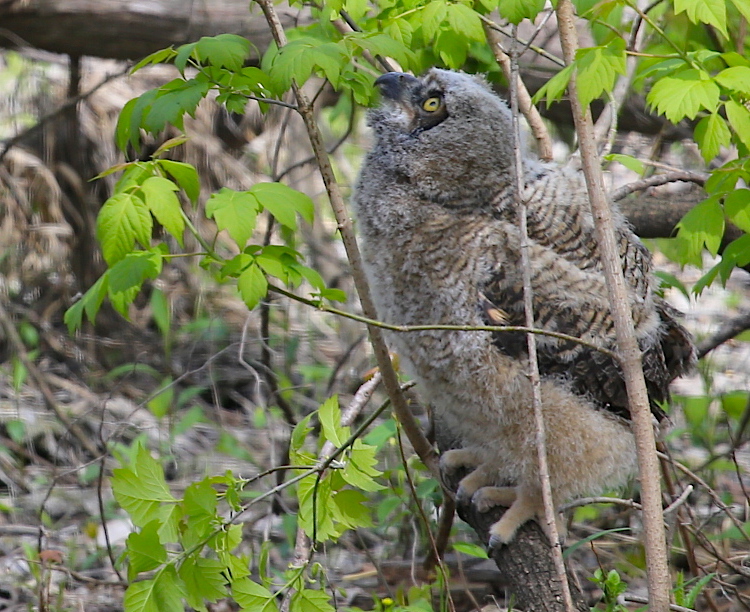


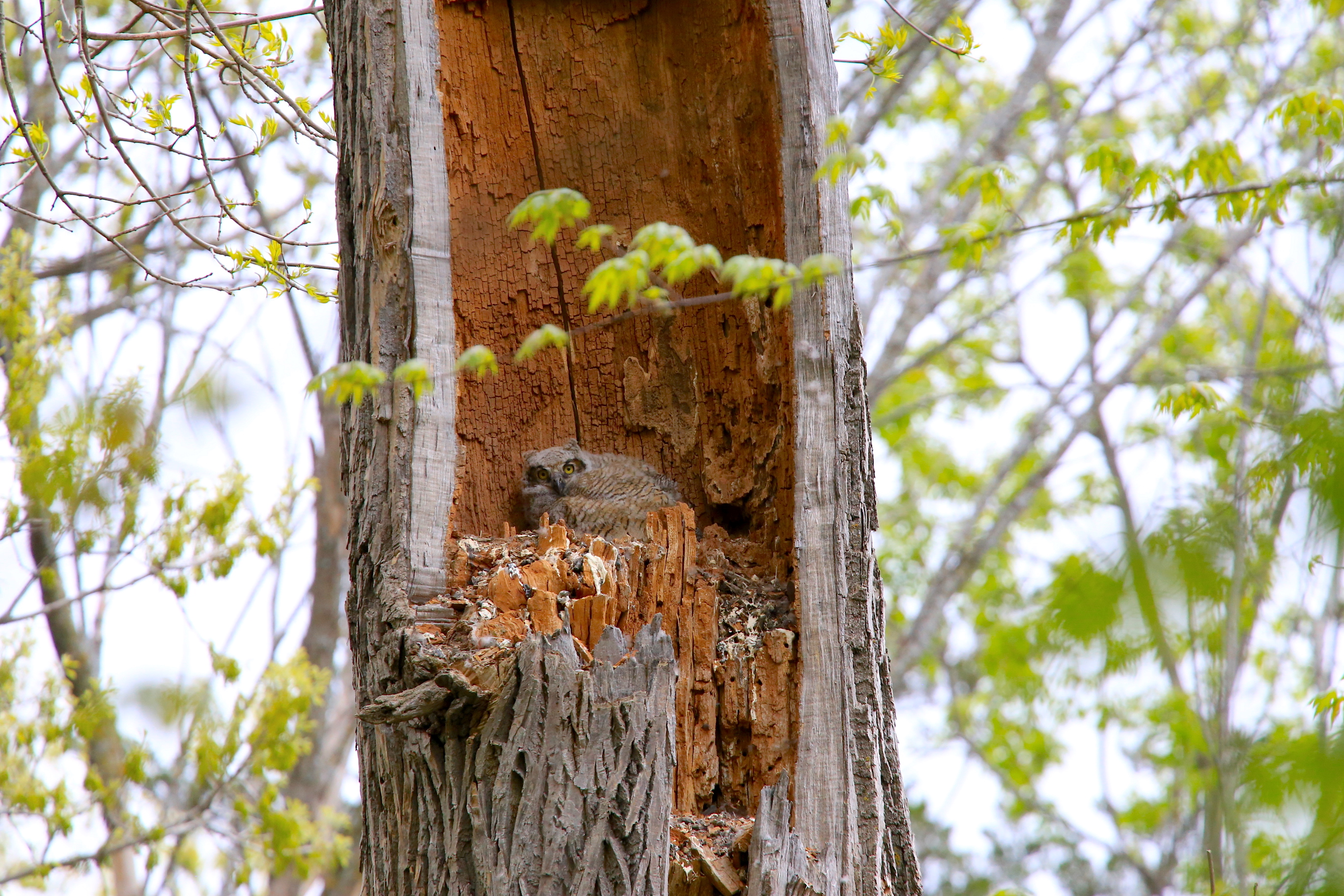
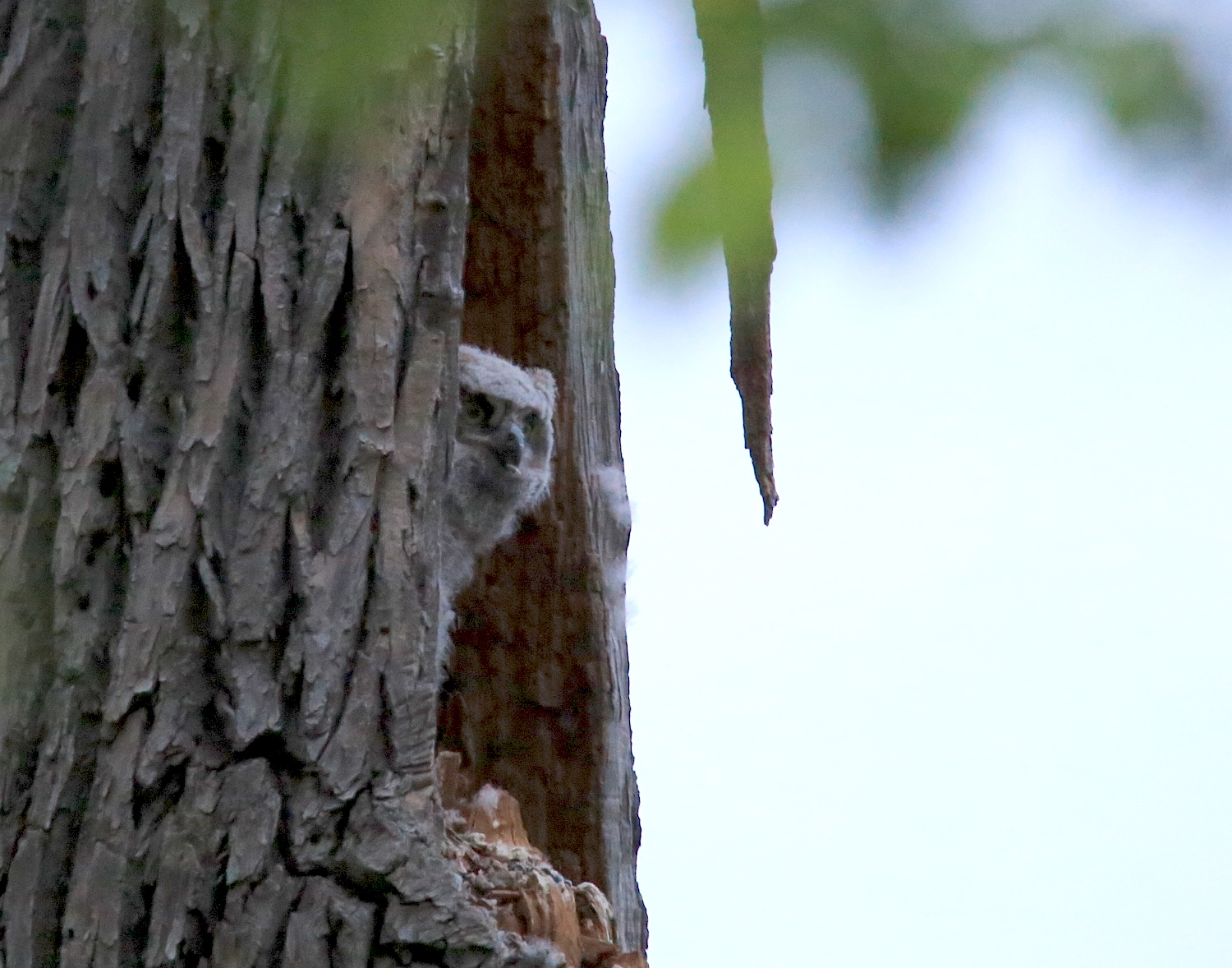

We decided on a sturdy clothes basket tied to the top of a ladder. It worked for a few hours, then the young owl decided it wasn’t going to stay there and jumped out to the ground and waddled towards the river. As fate would have it, it found a tree to climb up near the river and is now sitting about 20 feet above the river bank, and about 60 feet away from the original nest.
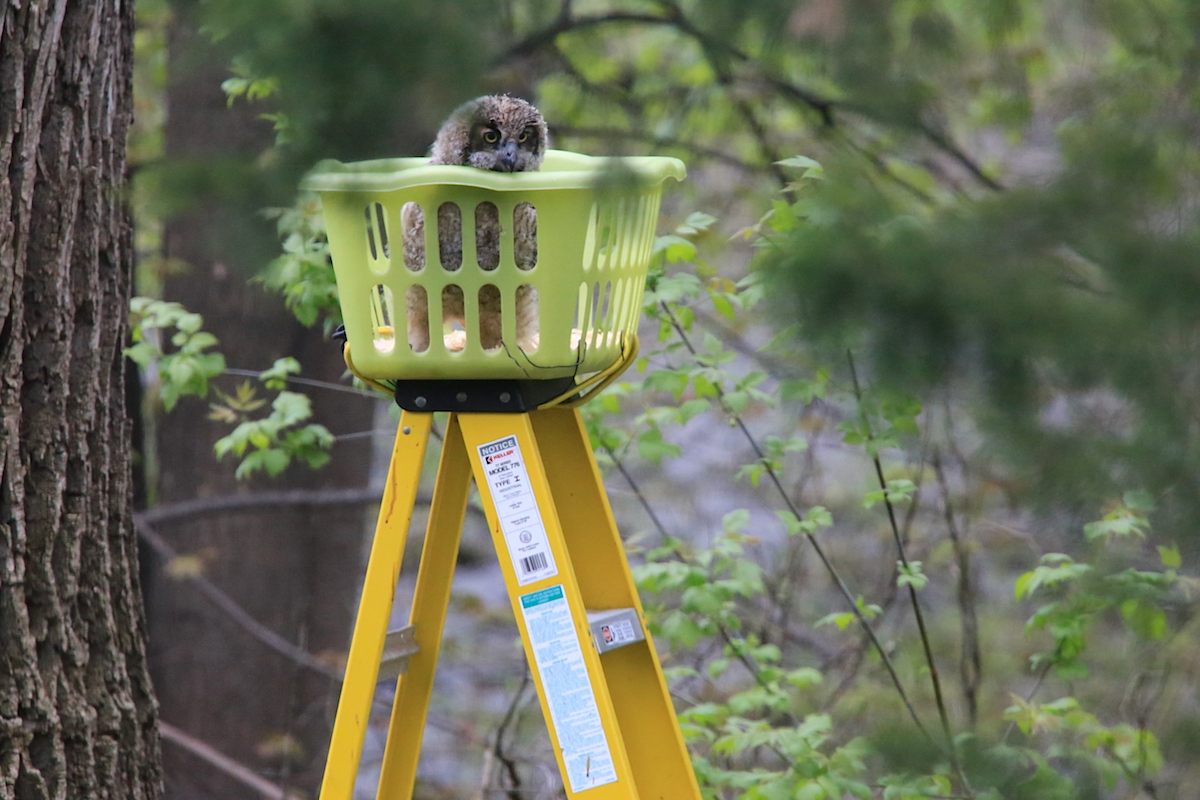
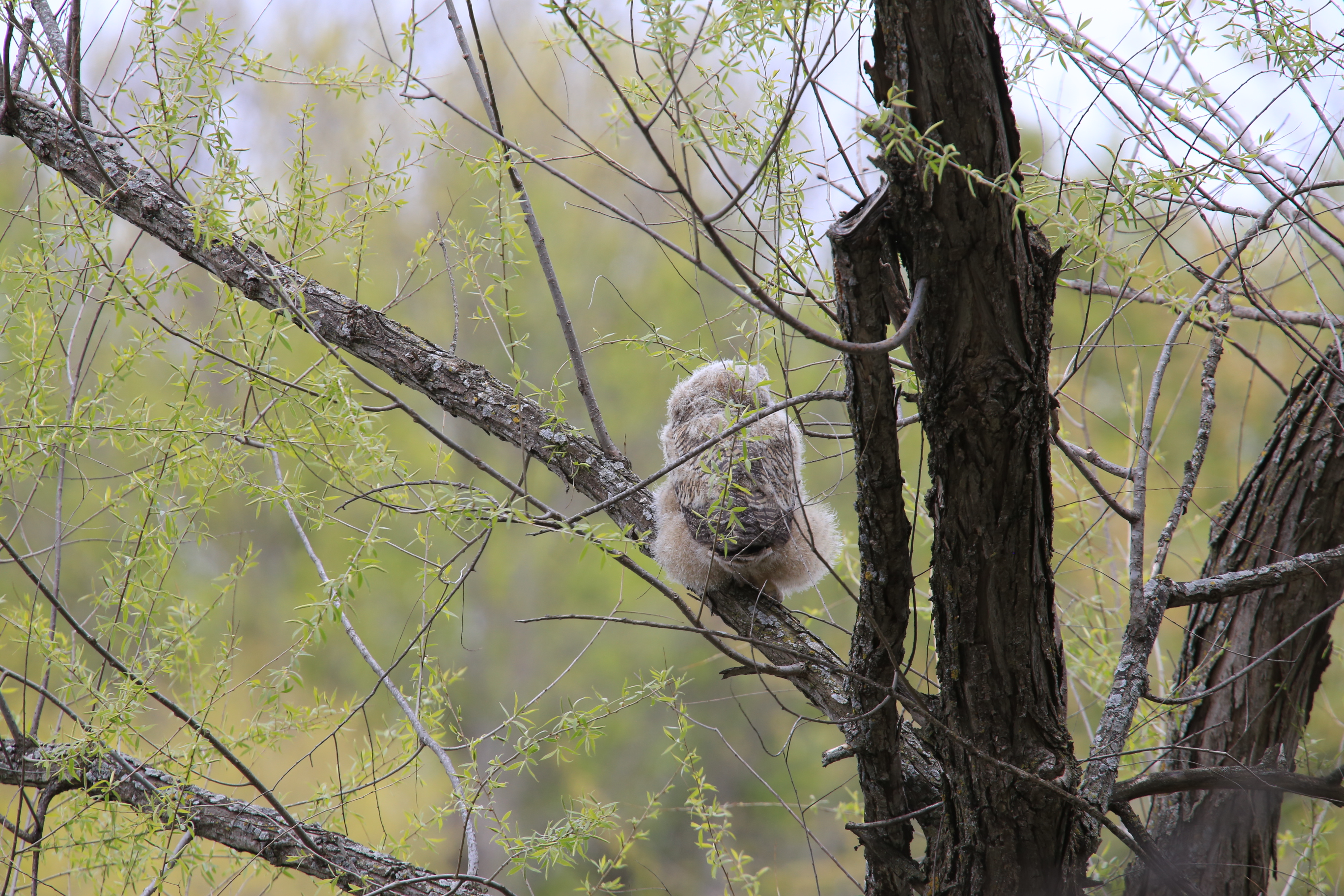
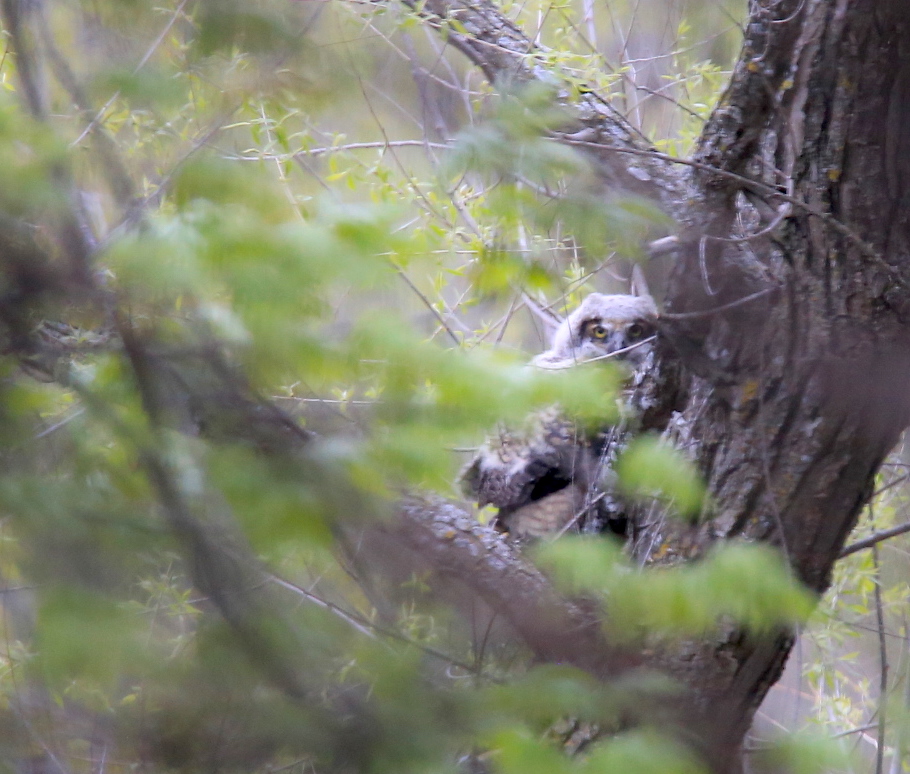
The next morning I noticed the young owl was nearly at the top of the tree it had climbed up. I captured this picture with Dad.

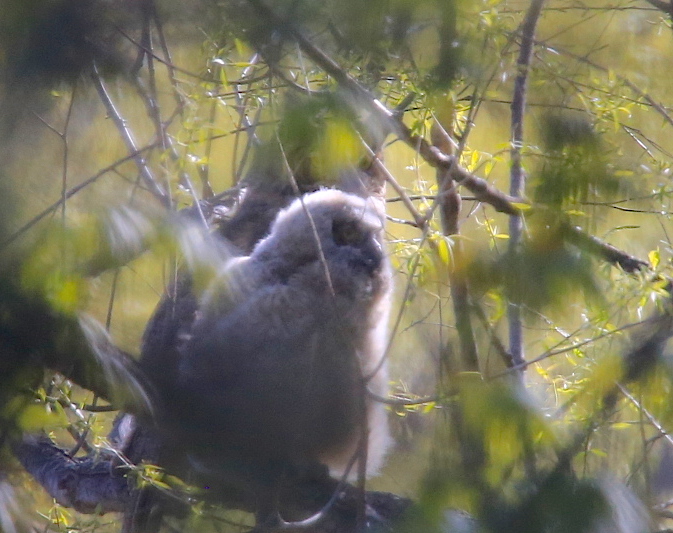
Baby Great Horned Owlets
May 6th, 2020
Today I took a couple of photos of the baby great horned owls nesting on the Crow River in Wright County, Minnesota.
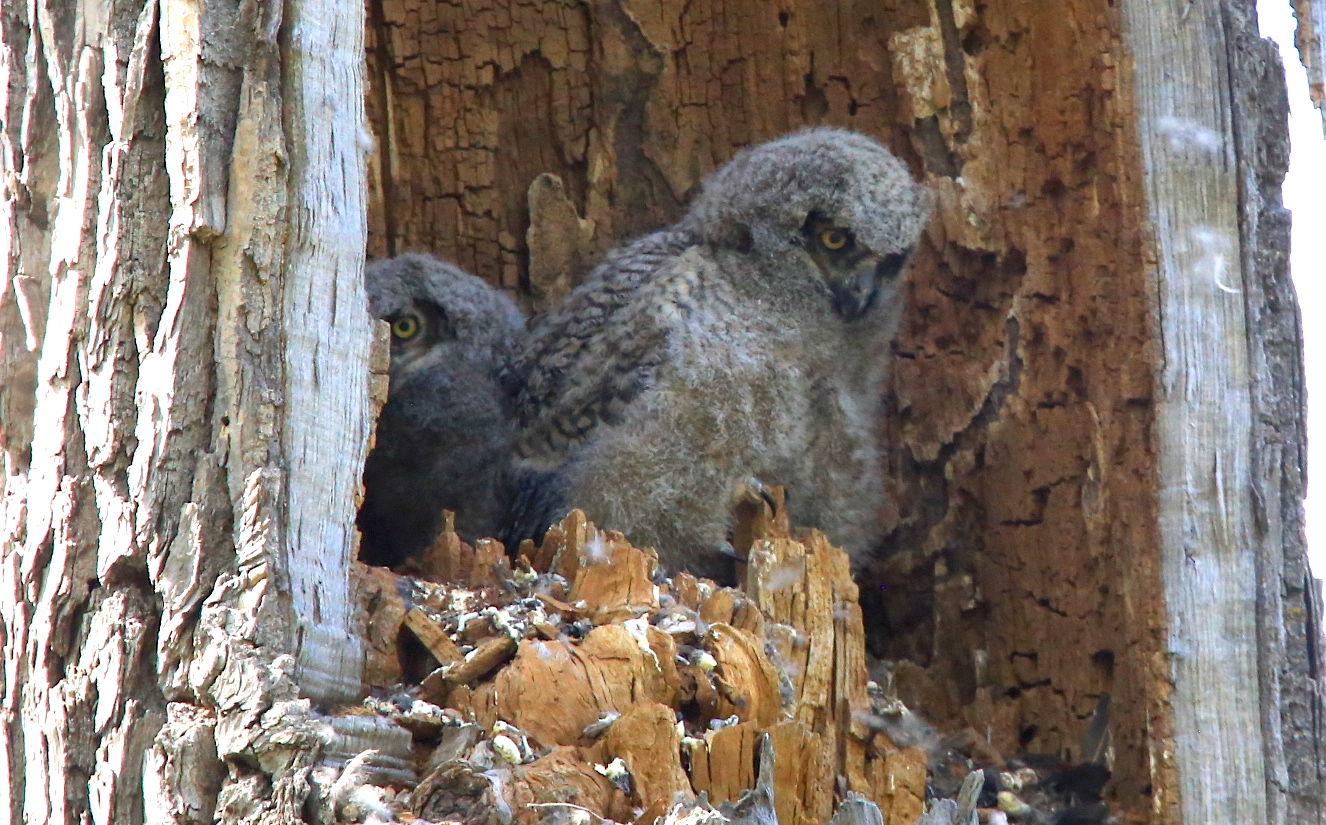
They “click” their beaks at me when they see me.
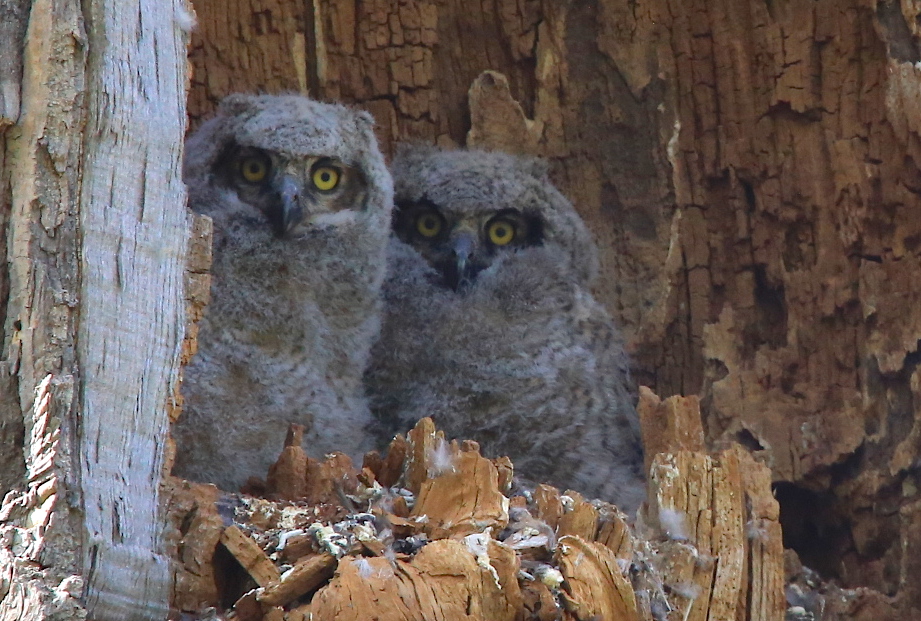
Unaware I was standing in the woods, this mother great horned owl was feeding her two chicks. I managed to get back away without being noticed.
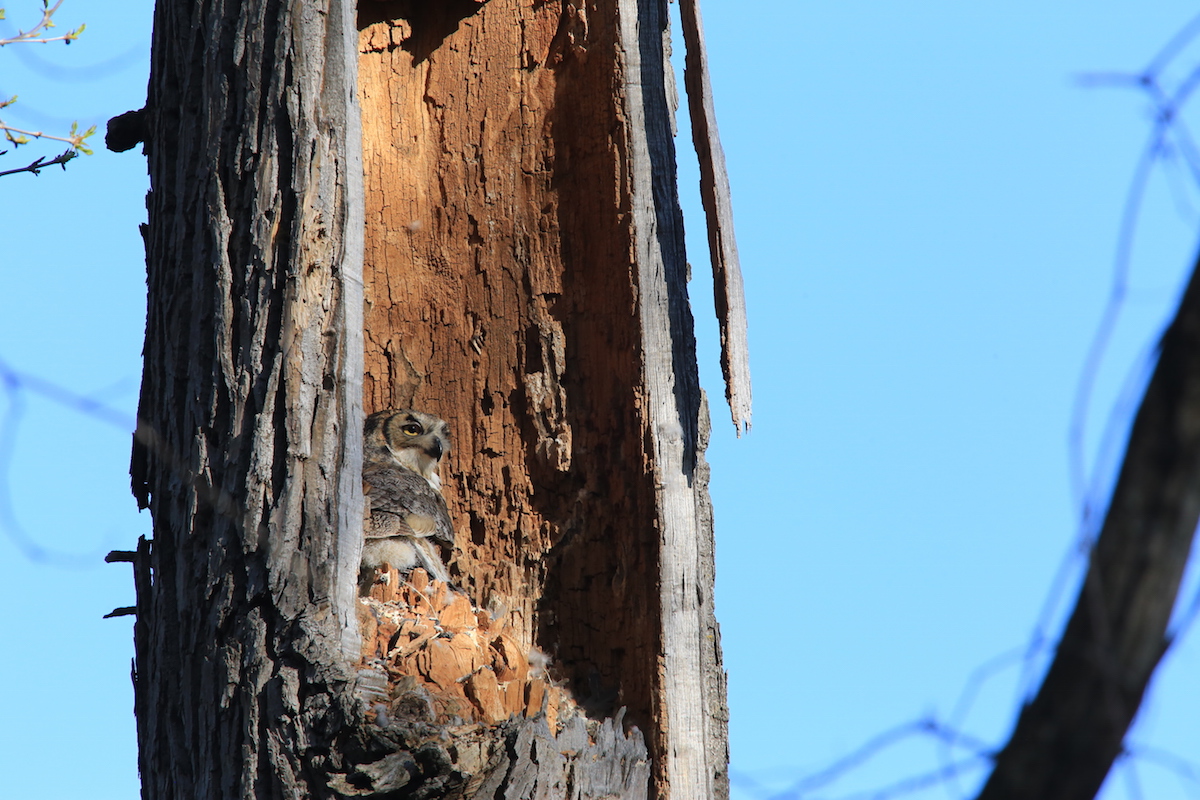
Father great horned owl spends his days resting near enough to the nest to be a deterrant for predators.

April 26th, 2020
This morning 4-26-2020 I decided to see if I could get a shot of the baby great horned owls nesting on the Crow River in Wright County Minnesota.
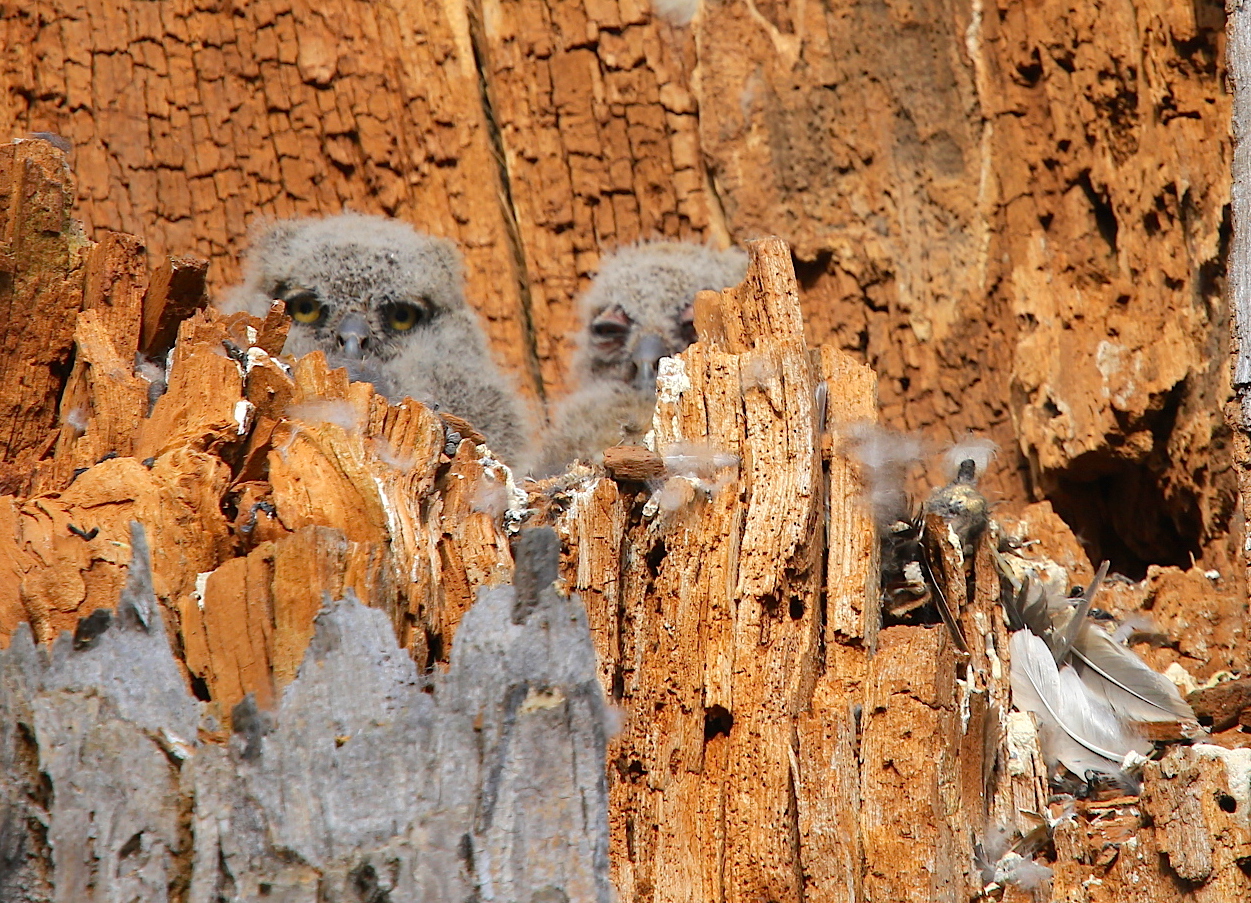
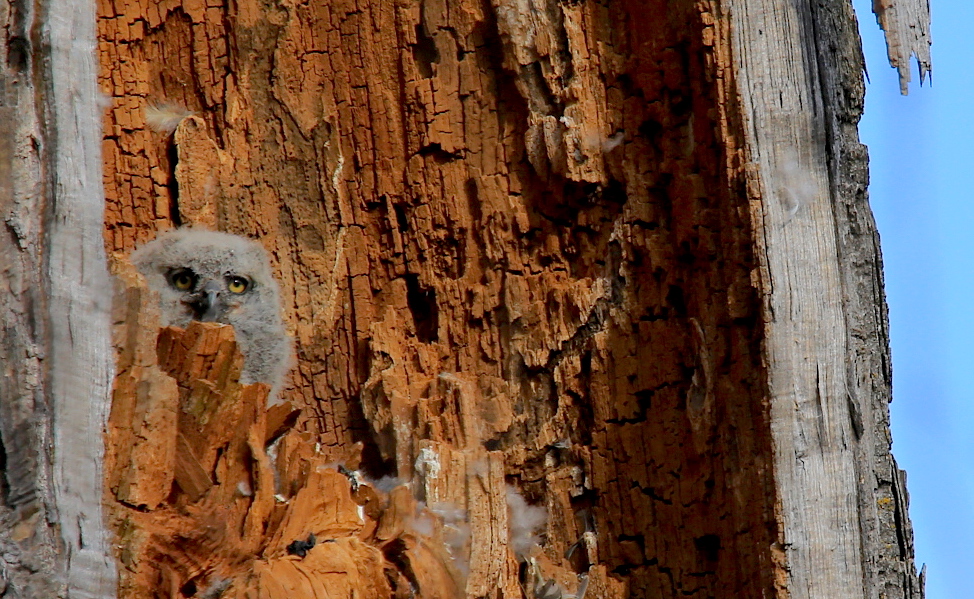
I took a couple of pictures of a baby owl (owlet) in the nest today – Tuesday April, 21st, 2020.
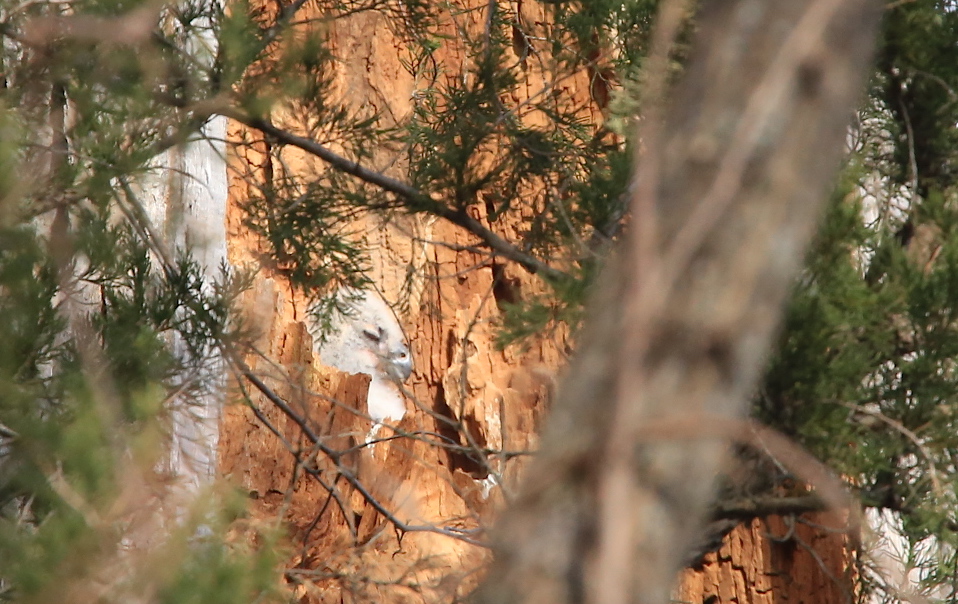
I saw two, but only captured this one, who (punny?) is sleeping at the moment! I did see both moving, but was unable to capture them.
Female Great Horned Owl
This female great horned owl is nesting on the Crow River in Wright County Minnesota. Her nest is on a shelf left from a windstorm that snapped the tree off. You can see her “ear” tufts and the “v” shaped dark feathers outlining her head. She is sitting on the eggs at this point. This was the first time I saw her March 15th, 2020. I am using a 640mm lens on full zoom here. She didn’t notice me, and I managed to get away without disturbing her.
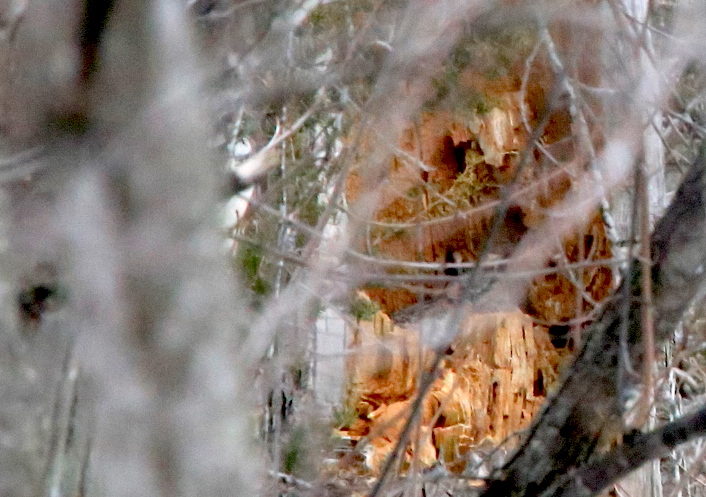
Here’s a better “where’s waldo” shot – April 10, 2020. She knows I am here and she is trying to “be small” so I don’t see her. As soon as I turn my back to her, she flies off the nest. She knows, just as I do, when we are looking.
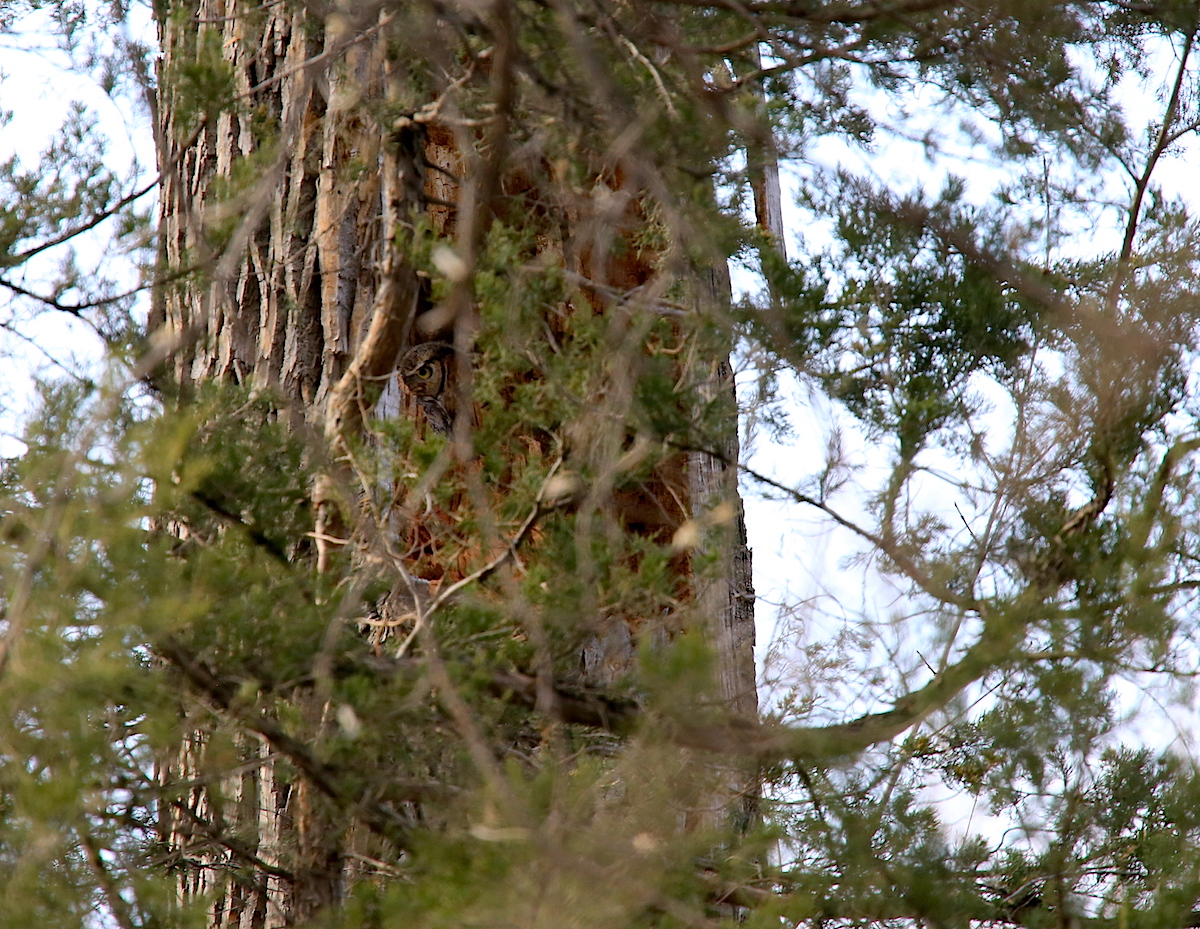
Many ancient cultures believed the great horned owl to be a bad omen, believing that they could be “shapeshifters” that were actually bad actors or witches embodied in the owl – considering them the bird of death. They believed the great horned owl represented bad things to come. While some considered them good luck.
Regardless of ideology, or other conjurings, nature has set the stage for an apex predator to reap the benefits of the environment… and here they are! So many squirrels, chipmunks, muskrats, fish, and everything else a great horned owl will eat, are plentiful here in the year 2020 on the Crow River in Wright County, Minnesota.
She is big! Her wingspan is around 4-5 feet!
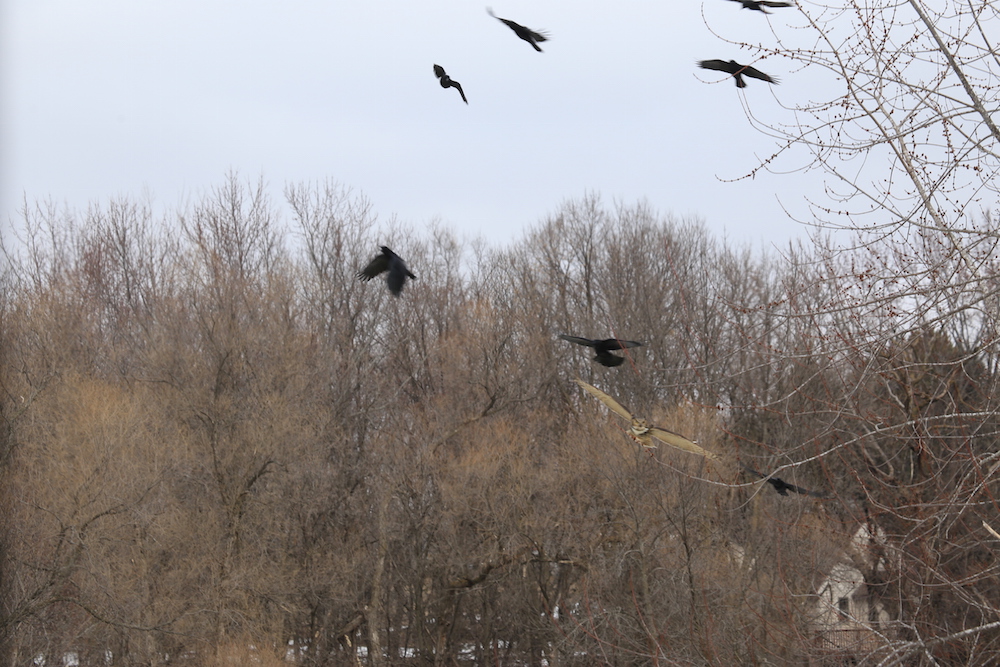
Crows and great horned owls have long been stealing one another’s eggs, and young, creating a long standing feud, so they harass her on her way back to the nest. Crows have been known to go harassing owls for hours at a time.

She’s flying in to the nest tree.
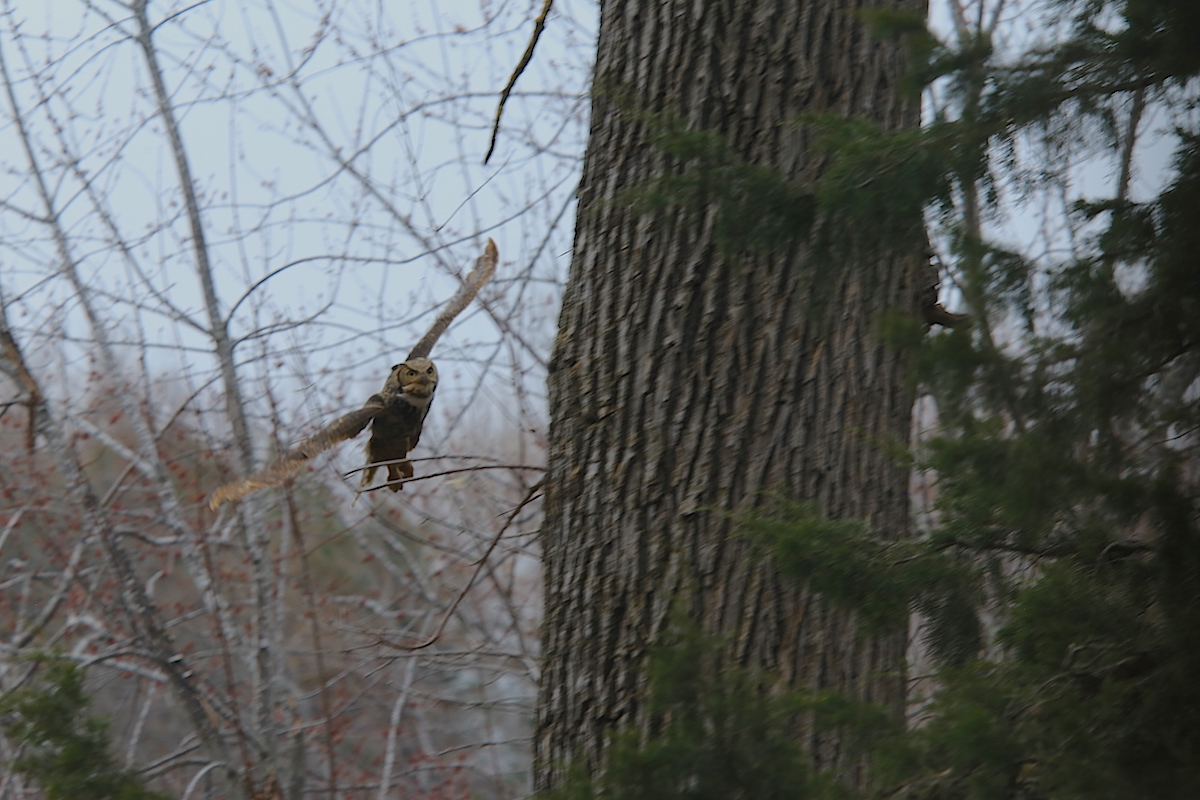
Again, flying into the nest.
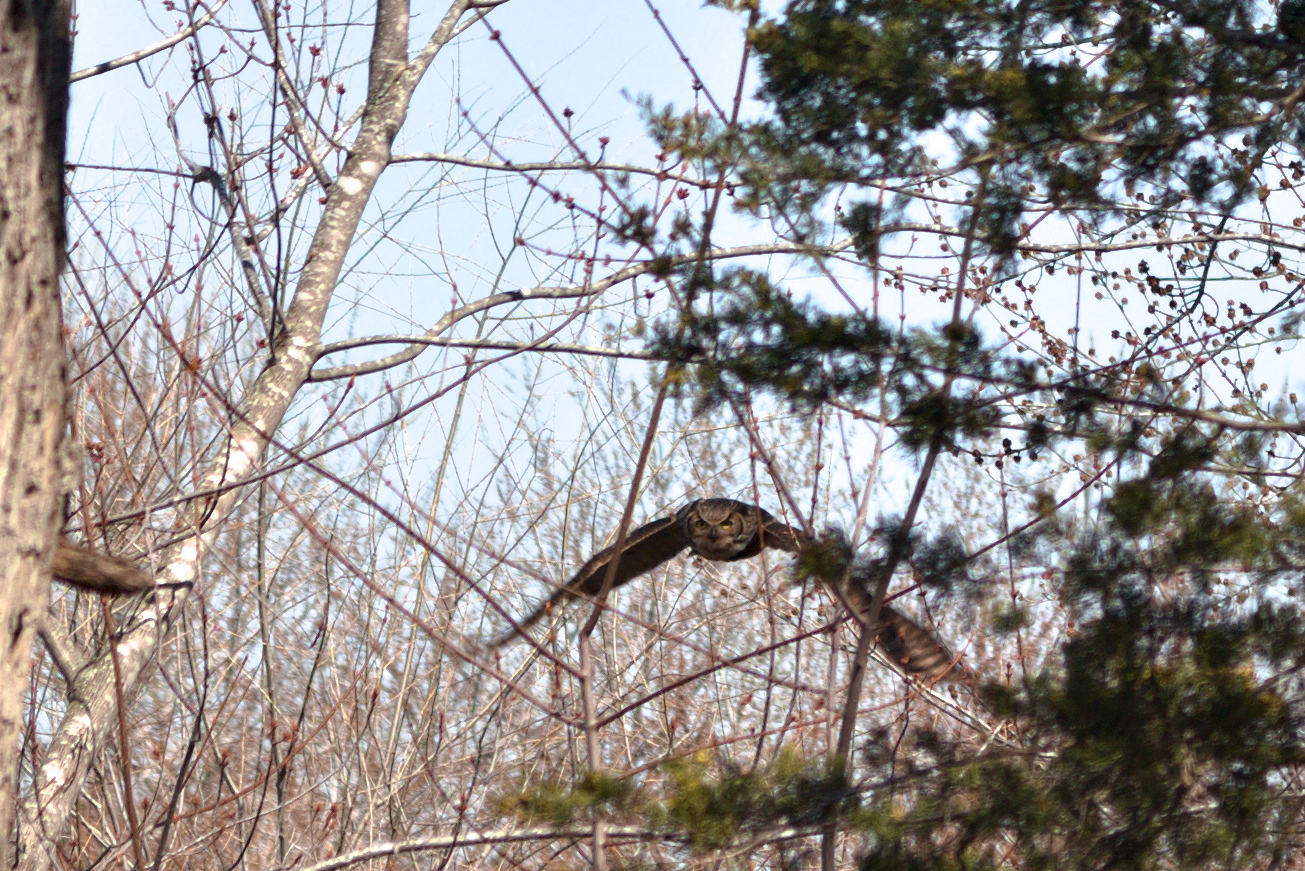
They are also called “tiger owl” because they prey on so many animals – eagles , and red tail hawks being their equal in terms of predators. Great horned owls are night hunters primarily, able to hear and see very well with minimal light. They get a lot of mice and small rodents. Because they have a poor sense of smell, great horned owls are able to ignore the intense stench of a skunk. One study following great horned owls found the remains of more than 20 skunks near the great horned owl’s nest. Their grip is said to be many times stronger than a human grip, capable of crushing its prey’s bones before eating it. They eat small critters in one gulp (whole – teeth, bones, guts and all) “barfing up” what they don’t digest in what has become known as an “owl pellet“.
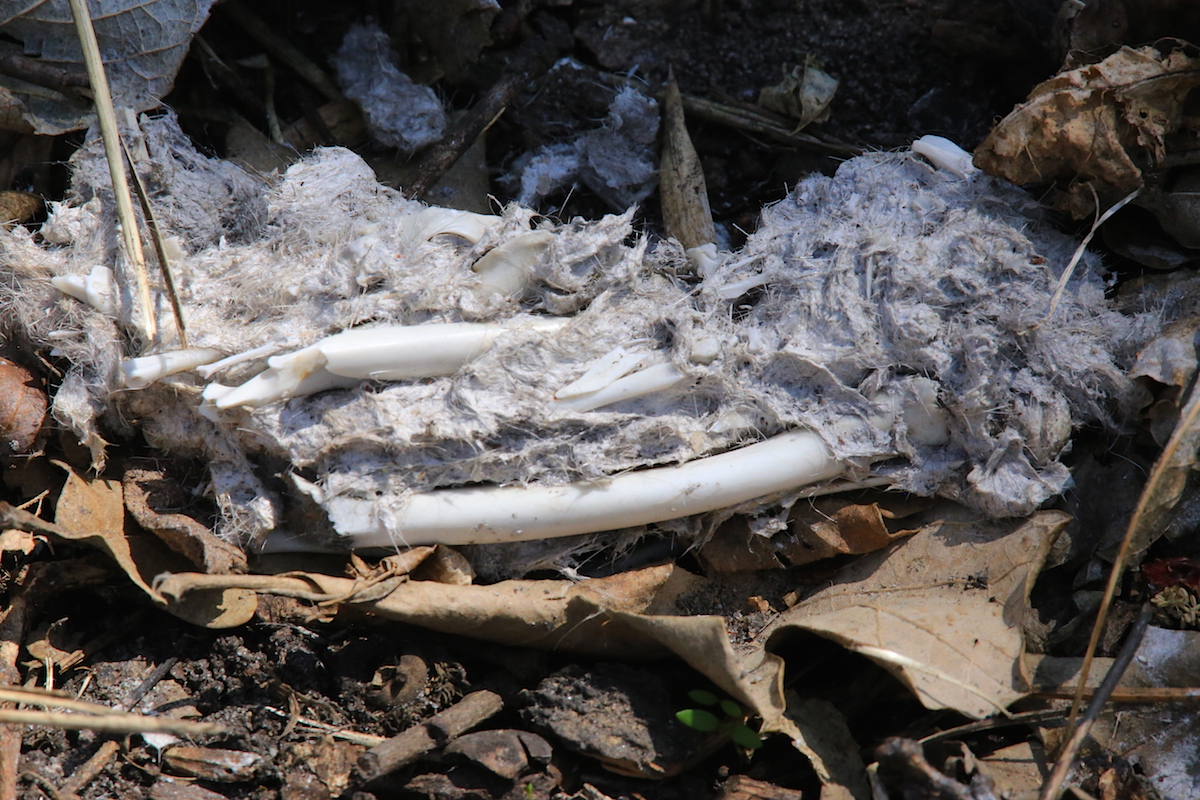
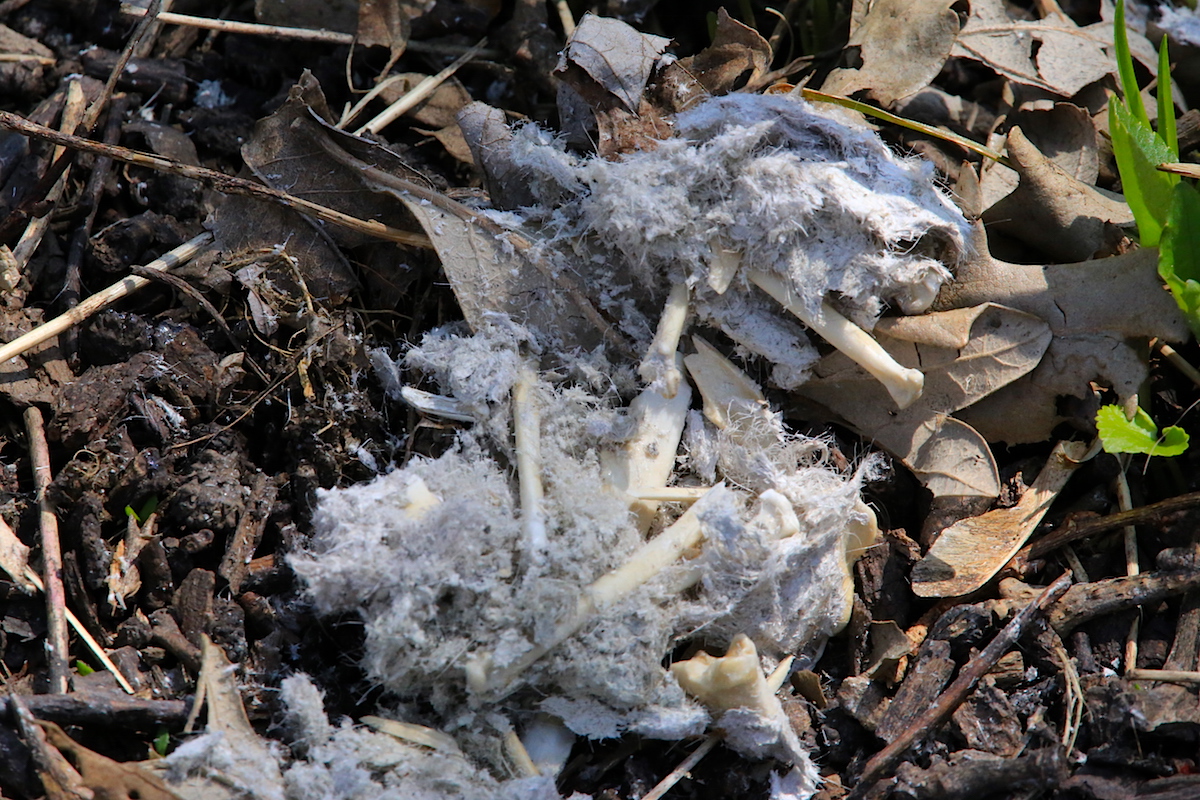
We used to have many barred owls – so many that every 1/8th mile or so another would take up residence. Lots of mice here along the river for them to feed on. This year I haven’t heard the crazy barred owl sounds, but my neighbor about 1/4 mile up the road seems to have one (probably nesting right now or soon). I don’t hear any barred owls now that the great horned owls are here. Great horned owls will hunt and kill/eat barred owls. They’ve also reportedly been found tangled together while fighting unable to get untangled, as male whitetail deer and bald eagles have been found to do during mating season.
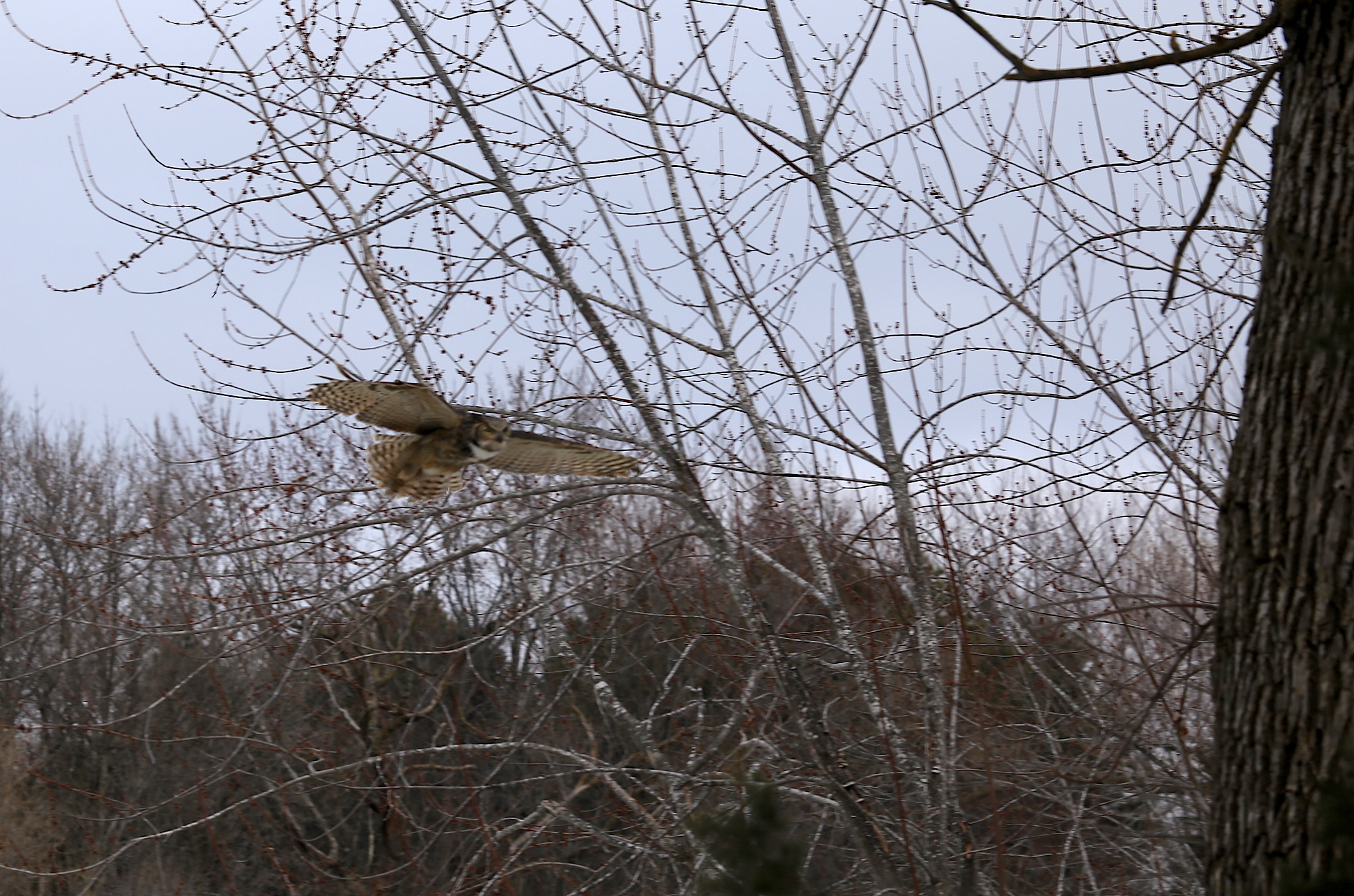
Male Great Horned Owl
The male great horned owl spends his days sleeping near the nest, chasing off potential predators during the incubation period. He’s a bit smaller than the female with a wingspan of about 3-4 feet.
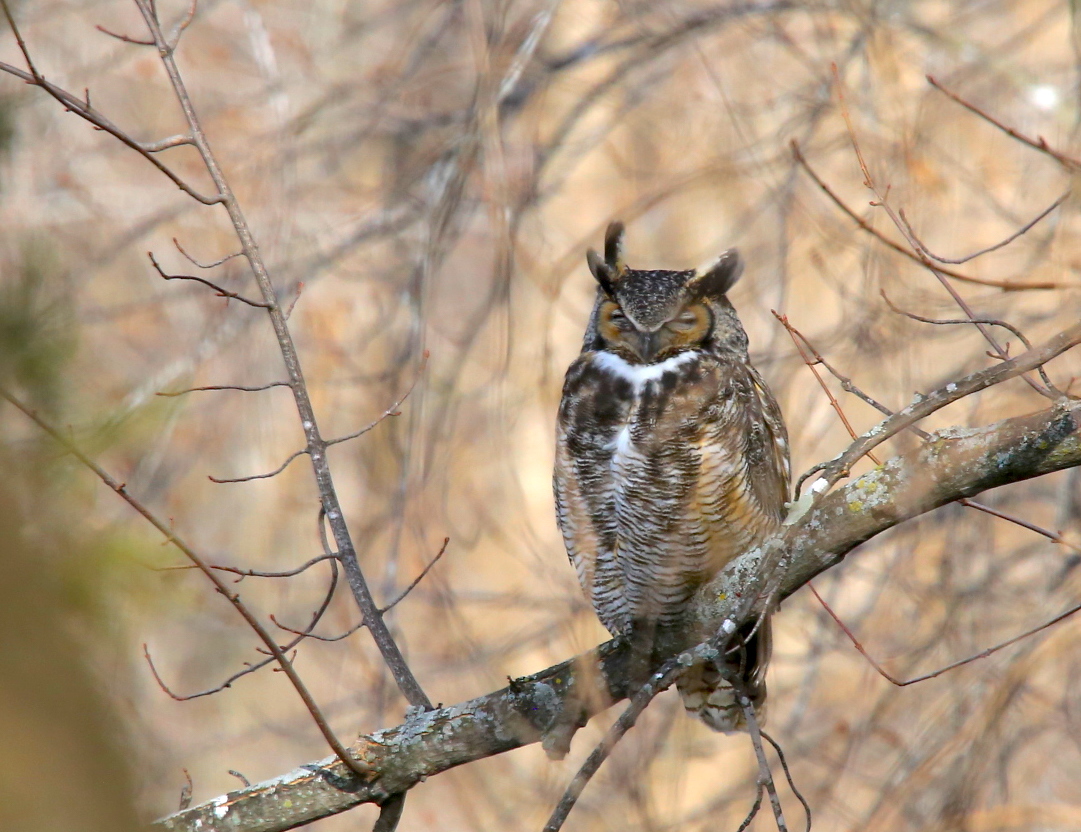
He slept there on that branch for a couple hours. Squirrels rustling nearby wasn’t interesting, but every once in a while he’d suddenly wake up and take notice due to some noise he heard.
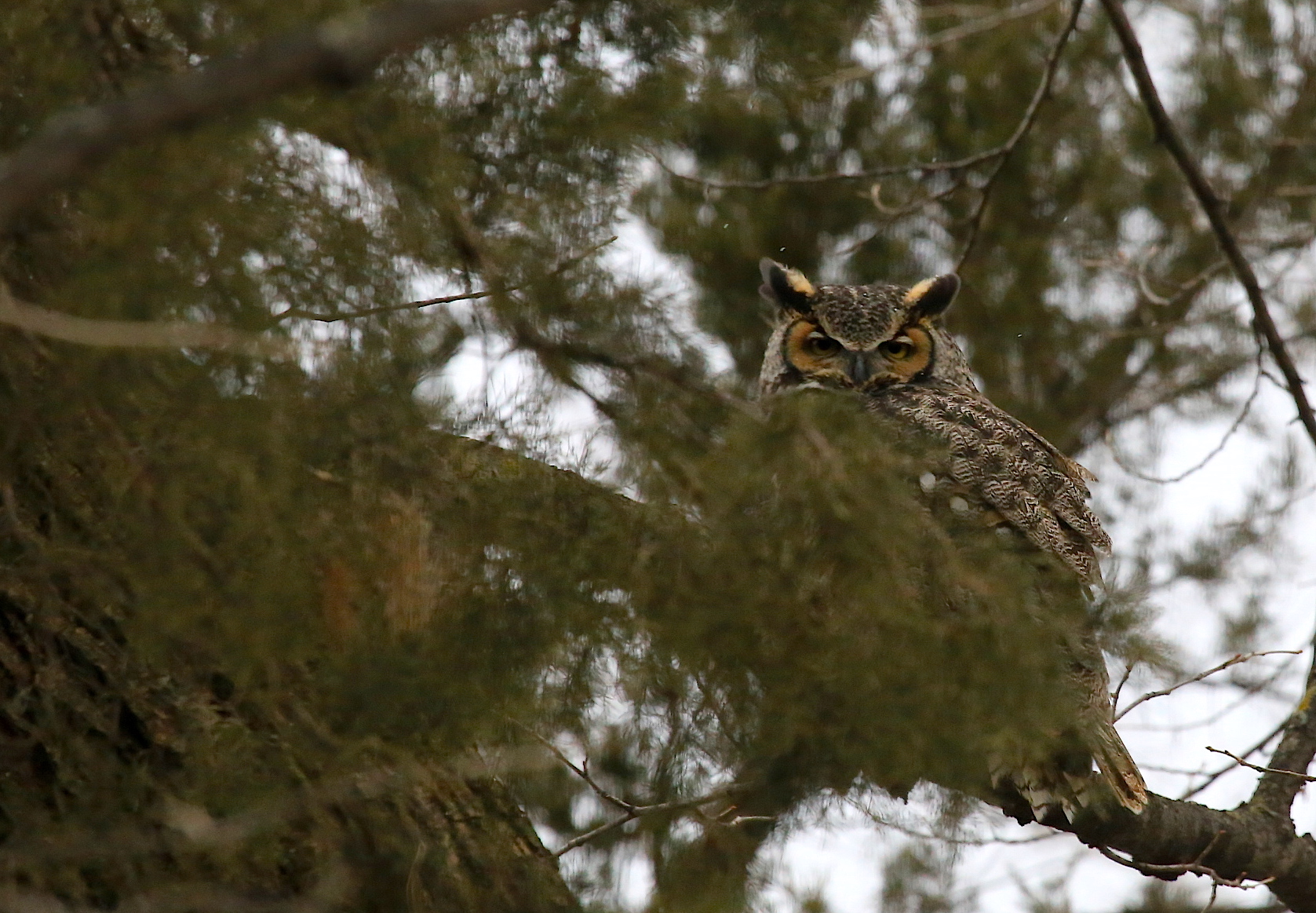
Here he’s looking directly into my lens. I’m standing in my bathtub looking out a small window where I noticed him.

He saw me move and decided to go to another perch.
Male Great Horned Owls come close to the nest and start a duet with the female – usually starting at around dusk, but I’ve heard them hooing at each other at many times during the day.
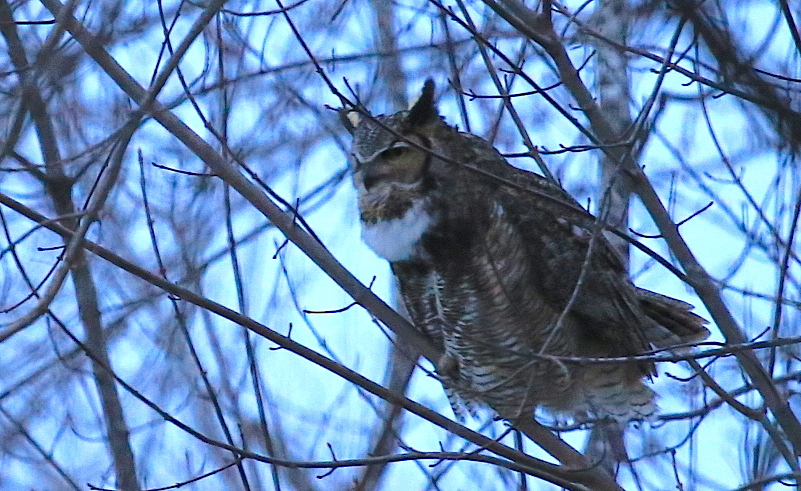
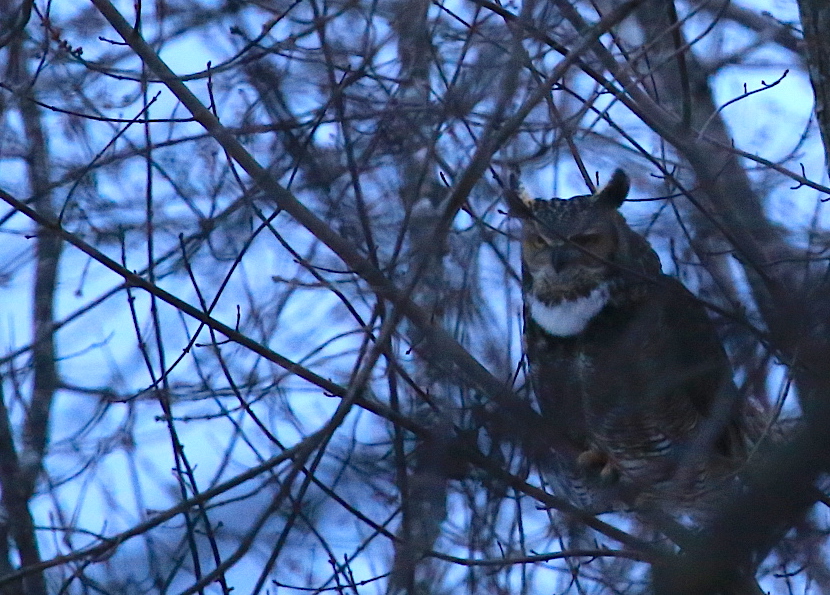
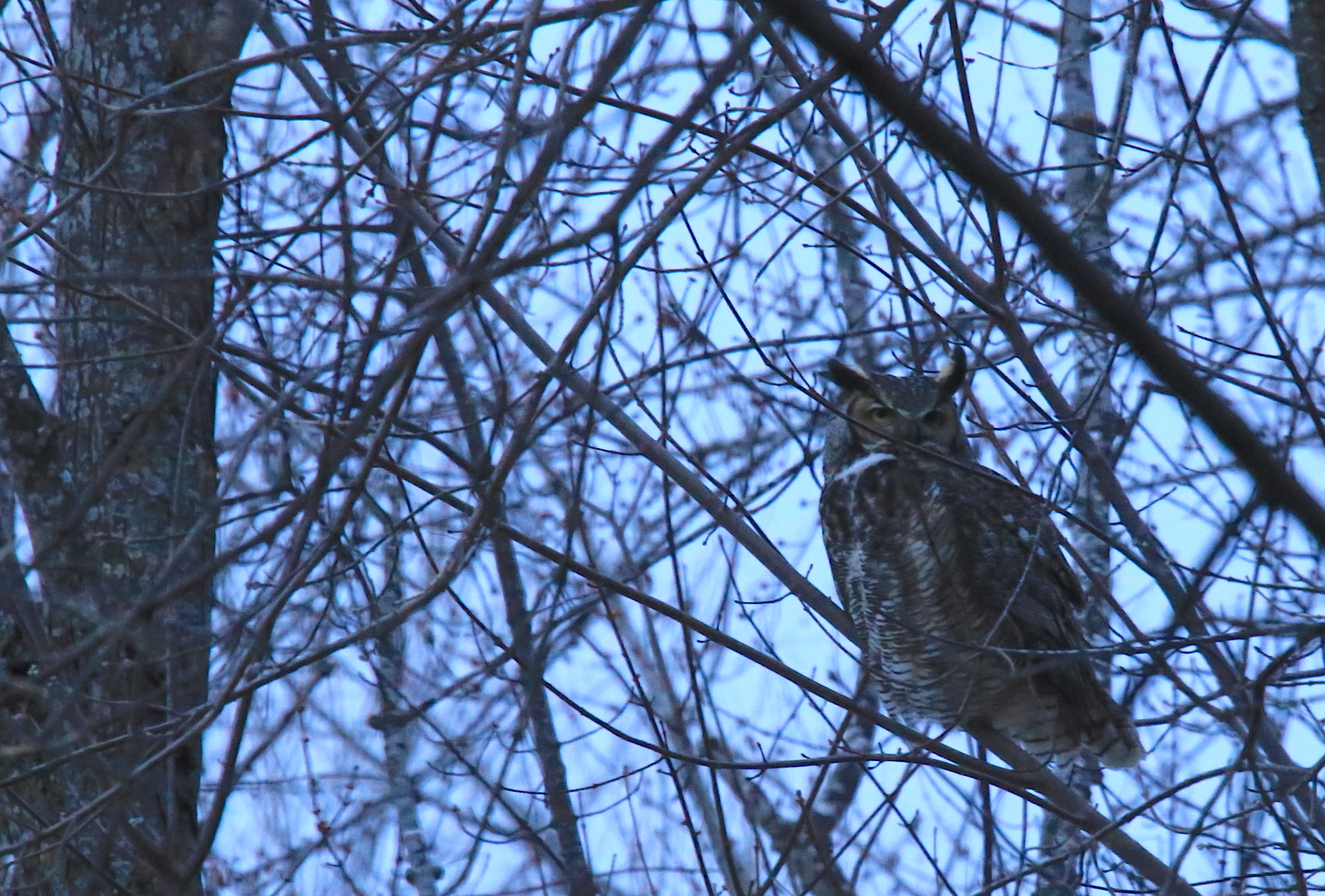
Male great horned owls will dive bomb any predator near their nest. I watched him dive bomb this mink who took a path underneath the nest tree. These photos were after the fact.
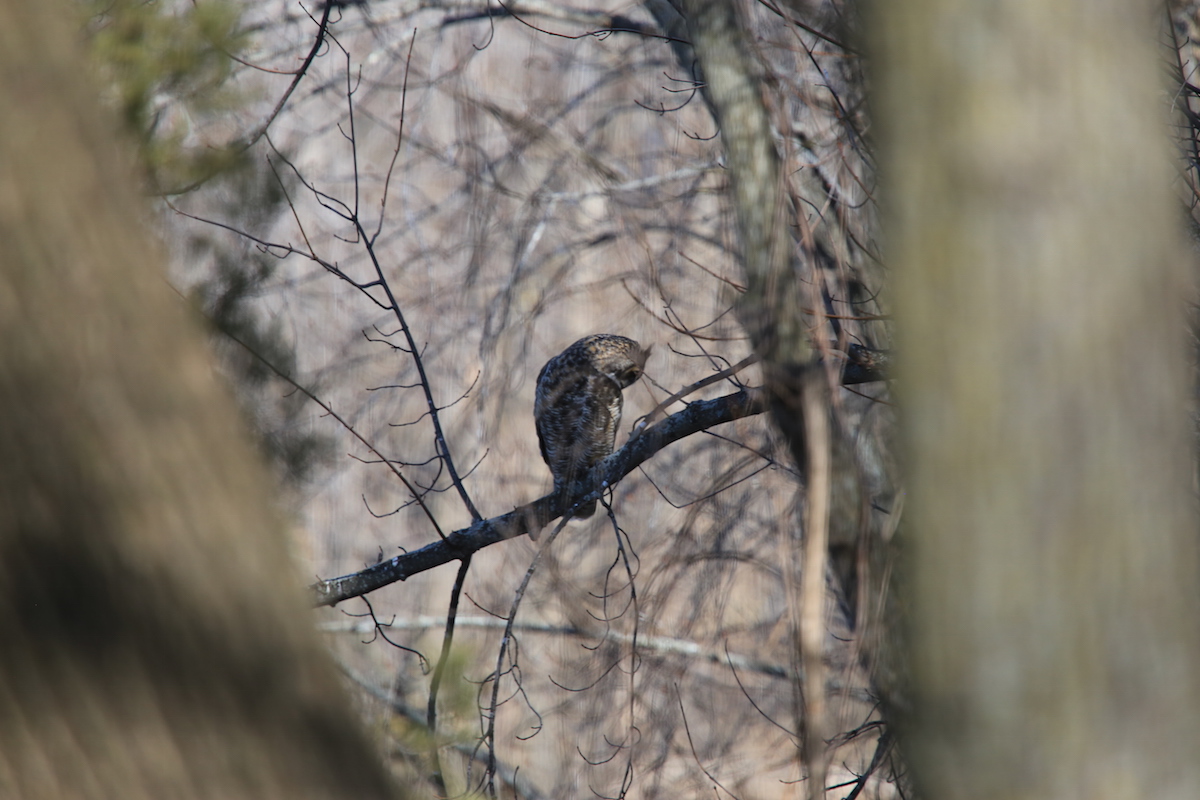
He kept an eye on this mink as it swam away.
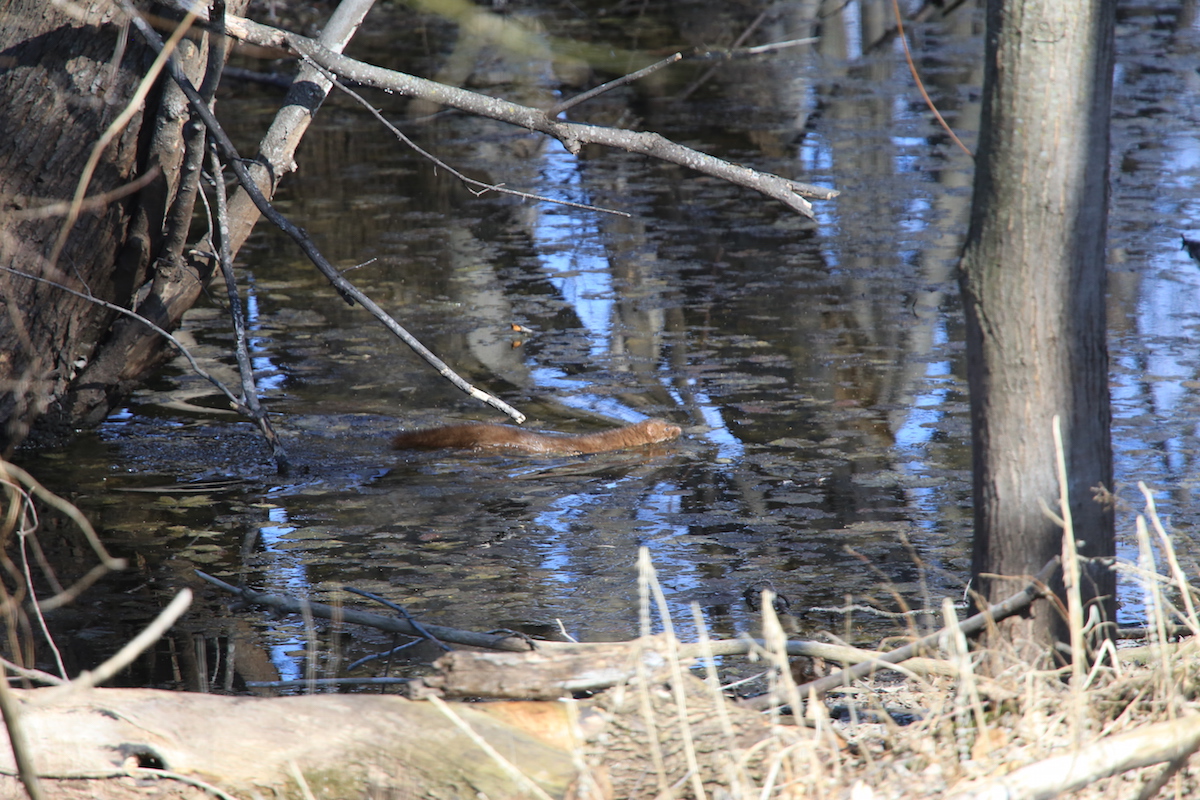
This group of noisy ducks fighting over a female under the nest were also dive bombed just after I took this photo (I missed the shot).
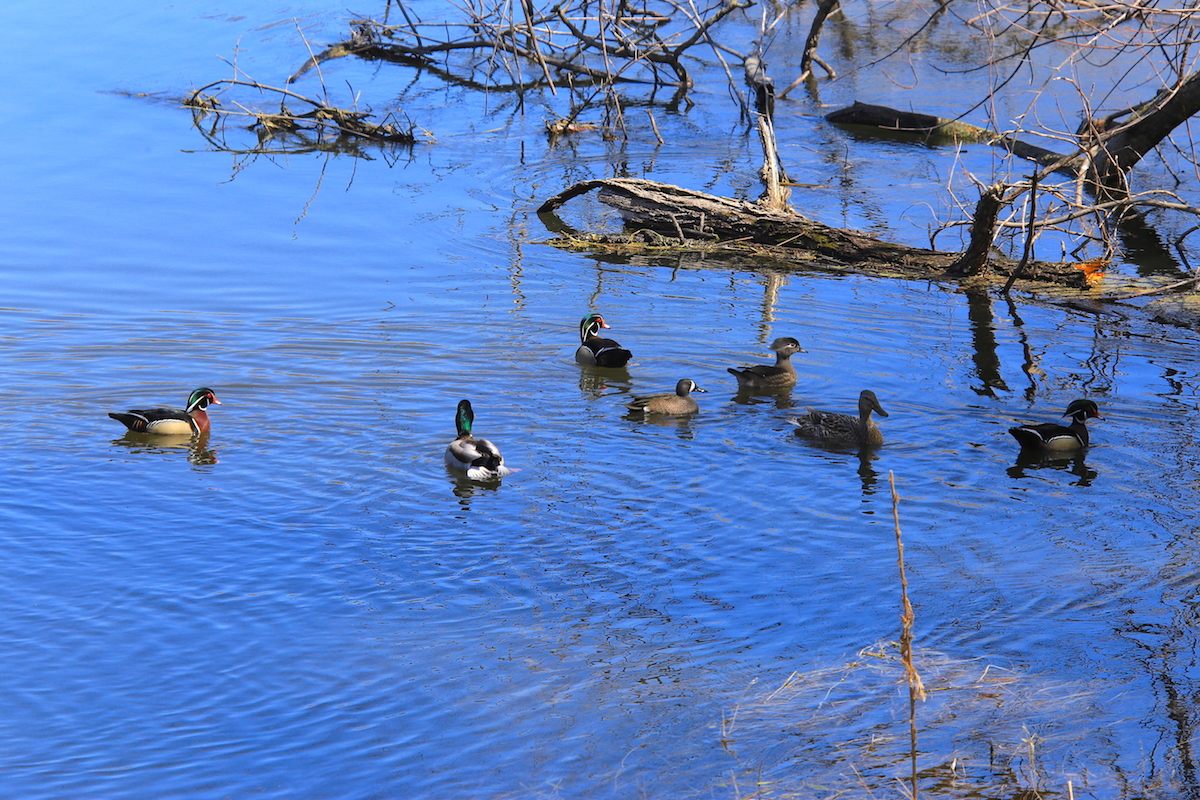
This cat is lucky – an earlier video showed the cat heading towards the nest tree area, then this video when the cat returned (all water that direction). The owl made a “click” sound when it was nearly upon the cat, which you will see the cat react to when the owl is nearly on top of it. When you see the cat suddenly turn around and look towards the camera at 6 seconds (halfway), I believe the owl “clicked” its beak while sitting on a tree branch above my house. This link is a video on an external website of a young great horned owl clicking it’s beak as a “stay away” message. Owls are nearly silent when they fly, but when I listen close to my video I think I hear a whirring sound as the owl goes past the roof overhang. Regardless, this cat was completely unaware of what was stalking it , even after the owl was long past the cat was utterly clueless about what just happened – which is probably why they call it “tiger owl”. Tigers strike without warning, usually from behind.
March 3, 2020

